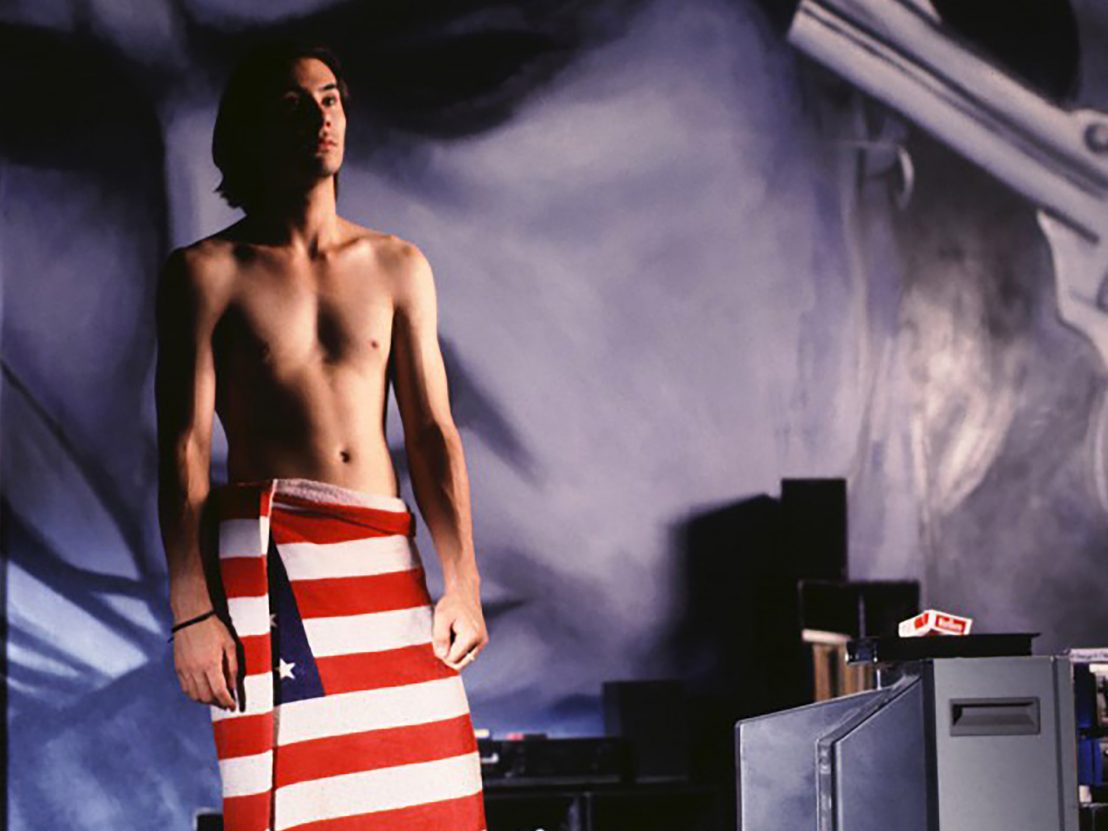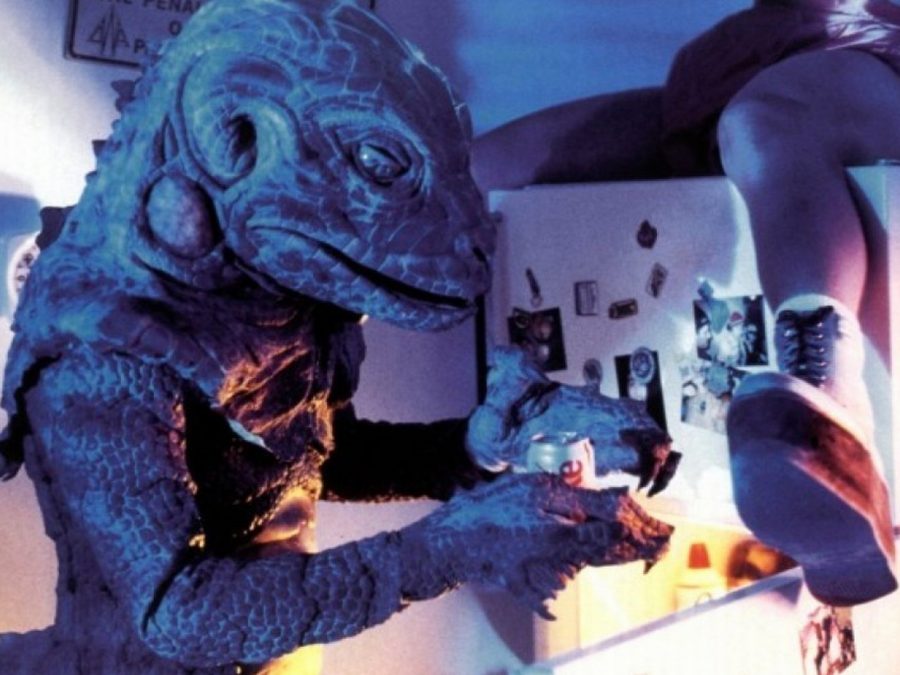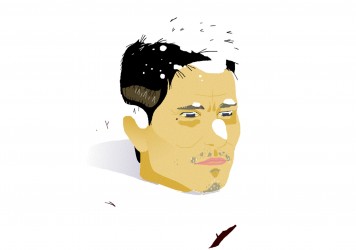
A Gregg Araki film, besides an omnipresent joie de vivre in the face of certain annihilation, is characterised most distinctively by the intrusion of nightmares into youthful fantasy. The final entry in his informal Teen Apocalypse trilogy, Nowhere, blurs the line between the two to the point of disorientation. Described in its purest terms as “Beverly Hills 90210 on acid” by Araki, the film’s synthesis of evangelical TV broadcasts and Hype Williams channels its manic energy towards paranoia, rather than the cathartically violent release that defines his early work.
Is the Rapture that megachurch propagandists exclaim the imminent arrival of through the hazy static of late-night TV the end of humanity as we know it, or is it merely the name of the Siouxsie and the Banshees album? The lanky, figure cast by Dark – one of a range of apocalyptic ciphers played by James Duval throughout Araki’s oeuvre – is the aerial through which transmissions of the apocalypse are broadcast.- He is plagued by dreams whose resemblance to the medium of video renders them more vivid than anything he experiences in his freewheeling everyday life.
Where the creeping existential dread so discomfortingly latent in Araki’s early work stemmed from the compacted experiential cycles of young adulthood, leading to the sort of pressure-cooker paranoia that the Bonnie and Clyde-esque cross-America road trips of The Living End and The Doom Generation embody, the paranoia of Nowhere stems less from tangible spectres of inescapable homophobia. Instead, the formal grounding of the film in the aesthetic modes of MTV and of a particularly garish form of dramaturgical expressionism renders it closer to late Araki’s experimental playfulness. It is precisely its position as a bridge between the two stages of the director’s career that also situates it as a connector between two diverging portraits of queerness in two distinct cultural moments.
Beyond simply cementing Araki as instrumental to the New Queer Cinema movement, Nowhere also established him as uniquely in dialogue with generational anxieties on both the subsuming of outsider art into brazen cliché and the erosion of the self in the 21st century. What distinguishes the film from similar forays into adolescence, such as the Duval-starring Mod Fuck Explosion, is not the trailblazing fashion that inspired collections by Marc Jacobs and Kenzo advertisements. Nor is it the overt allusions to Varda’s Murs and the commodification of abstract art. It isn’t even the inimitable soundtrack bookended by Slowdive – instead, Nowhere has developed over the course of 20 years into a vital text on the terrifying prospect of living ontologically unmoored from anything except the looming shadow of monoculture.
One of the most apparent signs of the idyll of 90s consumerism being disrupted by the slow but sure onset of unpredictability is Roscoe the Alien, a hallucinatory entity that walks amongst the haze of smoke and neon that permeate Nowhere’s constant stream of parties. Not unlike the Mugwumps of William Burroughs’ Naked Lunch, these sightings reinforce a fracturing of Dark’s already unsteady grasp on reality, disrupting his now-mundane patterns of wandering through LA in a daze with the notion that there is a terrifying enormity underneath the surface of the Yayoi Kusama-inspired interiors.
That enormity manifests not only in the form of inexplicable aberrations in the form of alien invasions (a motif Araki uses to similar effect in Mysterious Skin), but also in the sheer vastness of emotional vacancy that surrounds him. For all the vivacity of the teens the film follows, there is a disconcerting detachment from the maintenance of any bonds beyond the momentary.
As the thin veneer of languor coating their lives is gradually shattered by disappointment, the film’s teens turn to a range of coping mechanisms to confront traumas both collective and individual, amongst which sexual embarrassment and gratification recur most often. It’s only when that gratification is denied, as in the case of Bart (Jeremy Jordan), a relapsing addict whose boyfriend leaves him to wallow in isolation that a creeping hopelessness settles in.

Nowhere is composed of a continuum of highs that its characters simply cannot live without, and so it is only when these highs stop inducing any sort of feeling that they resort towards seeking guidance in the immaterial. As the voice of a televangelist echoes across dimly lit teenage bedrooms, the young and desperate are lured towards the promise of salvation through a collective self-imposed torment. As in Araki’s earlier work, the tendrils of shame belonging to cult-like Christofascists penetrate the lives of queer youth with the destructive power of shame. Here, though, that destruction is wrought in the form of both literal and figurative self-implosion, as the self is eroded to the point where a physical vessel can no longer contain it.
Amidst the trail of mutilated bodies littering the glittering Californian hills of Nowhere, which gradually come to resemble a wasteland by the end of the film, there are also wastelands of culture, where the nation’s intrinsic myths of violent outlaws, extraterrestrial invasions and the relentless oversaturation of images. As Dark witnesses these myriad manifestations of inexplicable, collective schizophrenia, they increasingly intrude upon his conception of his very being to the point where the dioramas of personal crisis that characterise every space in the film, like the subjectivization of Bart’s bedroom into a purely expressive object through the projection of his internal monologue onto his walls, ring increasingly hollow.
Even Araki’s penchant for unbound, liberatory sexuality and delightfully crass dialogue increasingly resemble a Foucaldian prison, as Dark’s relationship with his oftentimes-lover Mel (Rachel True) is fractured by a possessiveness that is inherently at odds with the world that he resides within. The only thing that separates his inner and outer worlds is another hollow cultural fragment in the form of a Campbell’s tomato soup can – framed in much the same way as Warhol’s paintings – which shatters the barrier between paranoia and eventuality by indistinguishably mixing brain matter and blood with the soup pouring out of the can.
Faced with the dissolution of any possibility of self-actualization, Dark recedes to his bedroom, once again seeking solace in the form of framing himself as a mere filmic entity through his camcorder. It is only fitting, then, that the first expression of naïve sincerity in the film – between Dark and his classmate Montgomery (Nathan Bexton) – should simultaneously signify unconsummated queer love, as the fear of imminent apocalypse metamorphoses into the lingering promises of youth being gruesomely snuffed out. As the moonlight reflects off the blood splattered over a wordless Dark, the film seems to interrupt the spiral of paranoia with the realisation that the life-altering trauma that he has witnessed is merely the inevitable destination of youthful vitality with nowhere left to go.
Published 5 Jun 2023

By Logan Kenny
The film shows the everyday agonies of existing as queer and dealing with trauma in an apathetic world.

The mischievous indie auteur talks about the importance of shoegaze music to his new film, White Bird in a Blizzard.

By Sam Moore
Gregg Araki’s mid-’90s triptych explores the hope and hopelessness of being young and openly gay.